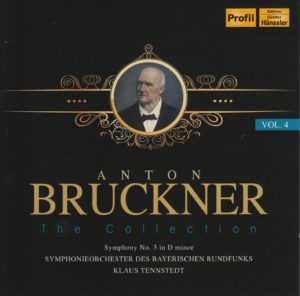 This morning’s conductor of Anton Bruckner’s Symphony No. 3 in D Minor (WAB 103), nicknamed “Wagner,” is German-born Klaus Tennstedt (1926-1998). The orchestra is Symphonieorchester des Bayerischen Rundfunks.
This morning’s conductor of Anton Bruckner’s Symphony No. 3 in D Minor (WAB 103), nicknamed “Wagner,” is German-born Klaus Tennstedt (1926-1998). The orchestra is Symphonieorchester des Bayerischen Rundfunks.
“What’s that?” I hear you ask, ever so politely.
“T” comes after “C” for Chailly and even long after “G” for Gielen?
 Yes. I know that. The CD in the Bruckner Collection box set of his Third Symphony was this one – conducted by Klaus Tennstedt. I am fully aware that Tennstedt should not immediately follow Chailly and come before Gielen. But, because the box set is called Bruckner Collection, and I’m taking these symphonies alphabetically by conductor name by box set, I put this under “C” for “Collection.” And “Collection” would, most definitely, follow Chailly – alphabetically speaking, of course.
Yes. I know that. The CD in the Bruckner Collection box set of his Third Symphony was this one – conducted by Klaus Tennstedt. I am fully aware that Tennstedt should not immediately follow Chailly and come before Gielen. But, because the box set is called Bruckner Collection, and I’m taking these symphonies alphabetically by conductor name by box set, I put this under “C” for “Collection.” And “Collection” would, most definitely, follow Chailly – alphabetically speaking, of course.
So that’s why Klaus Tennstedt follows Riccardo Chailly.
And, frankly, I’m glad he did.
I was familiar with Tennstedt before this project. (To be honest, I didn’t even know he was part of this project.) According to my order history on Amazon, I ordered Tennstedt’s Bruckner Symphonies 4 & 8 (EMI label) on June 26, 2009. So I’ve been familiar with Tennstedt at least that long.
And that jars my memory. It must have been Tennstedt conducting a Bruckner symphony that I heard on the local Classical radio station a number of years ago. I originally thought it was George Tintner. I knew for sure one of the conductors was Karajan. But I think I mixed up Tintner and Tennstedt because I just now realized that I ordered CDs by Karajan and Tennstedt within a week or so of each other back in 2009, shortly after hearing a Bruckner symphony on the radio.
According to his obituary (Jan. 13, 1998) in The New York Times, Mr. Tennstedt died of throat cancer.
The obit was kind to him, describing his style of conducting in this fashion:
Mr. Tennstedt’s style also drew comment at that time. Mr. Schonberg described him as “a croucher and dancer, a stabber and jabber.” Others depicted his conducting as athletic and angular. By the time Mr. Tennstedt reached his 60’s, his podium manner had grown more spare and restrained, yet he continued to elicit performances that offered both visceral power and vivid emotion.
A tribute to Tennstedt written, I think, by Michael McManus, appears on the Gramophone web site. It describes a brilliant, one-of-a-kind conductor
Klaus Tennstedt was a tempestuous man and his methods and techniques were far from orthodox, but those of us who had the privilege to share his music-making were changed by it. His studio recordings never did him justice but now, over a decade after his death, perhaps his live recordings do. It is quite some legacy.
The obit in the Independent (UK) offered additional insight into the life and career of Klaus Tennstedt:
Success came so late to Klaus Tennstedt it almost destroyed him. He was 48 when a stand-in concert in Boston drew sensational reviews, dates with the finest orchestras and more money and admirers than he could count. After a lifetime in provincial theatre pits, the limelight was all too dazzling.
Whirling around the hemisphere of world-class orchestras, he was ravaged by self-doubt: who am I to direct musicians accustomed only to the greatest?
From what I am reading (I did not know this), Tennstedt was known as a great interpreter of the works of Gustav Mahler (1860-1911).
All of these insights are terrific backdrop for today’s recording of Anton Bruckner’s Third Symphony, which is absolutely…well, let’s just save that opinion for the end, shall we?
It’s time to dive into the nuts and bolts of this morning’s recording:
Bruckner’s Symphony No. 3 in D Minor, composed in 1873
The version Tennstedt used is the 1889 version, edited by Nowak
Klaus Tennstedt conducts
Symphonieorchester des Bayerischen Rundfunks plays
The symphony clocks in at 52:10
This was recorded on November 4, 1976, in (I think) Munich, Germany
Tennstedt was 50 when he conducted it
Bruckner was 49 when he composed it
This recording was released on the Profil/BR Klassik label
Bruckner wrote his symphonies in four parts. The time breakdown of this one (Symphony No. 3 in D Minor, 1889 version), from this particular conductor (Tennstedt) and this particular orchestra (Symphonieorchester des Bayerischen Rundfunks) is as follows:
Misterioso…………………………………………..19:42
Andante, quasi Adagio……………………….14:41
Scherzo…………………………………………………6:51
Finale, Allegro……………………………………..10:55
Total: 52:10
Okay. Now for the more subjective stuff…
My Rating:
Recording quality: 4 (slight tape hiss, and a bit cavernous/echo-y in some spots)
Overall musicianship: 5
CD liner notes: 0 (there are none – boo! hiss!)
How does this make me feel: 5
I don’t know if when I read wonderful things about a conductor and/or orchestra I hear their music differently (is there such a thing as rose-colored earbuds?). But Tennstedt’s interpretation of Bruckner’s Symphony No. 3 in D Minor moves me, especially the Third Movement (Scherzo). It’s incredibly stirring, grand, and enveloping. I feel surrounded by this music.
This, so far, is one of the best recordings I’ve heard in my 144-day project.
By the time I got to the end of the Fourth Movement (Finale) I felt wrung out – but eager to jump to my feet applauding. It was like watching Star Wars and Luke just plunked the bomb in the hole on the Death Star. That kind of applause. Just an overwhelming feeling of triumph.
This is a very fine recording of a very fine interpretation by a very fine conductor and a very fine orchestra. (And, for all I know, a very fine city in a very fine country in a very fine year to be alive. But let’s not stretch it, shall we?)
